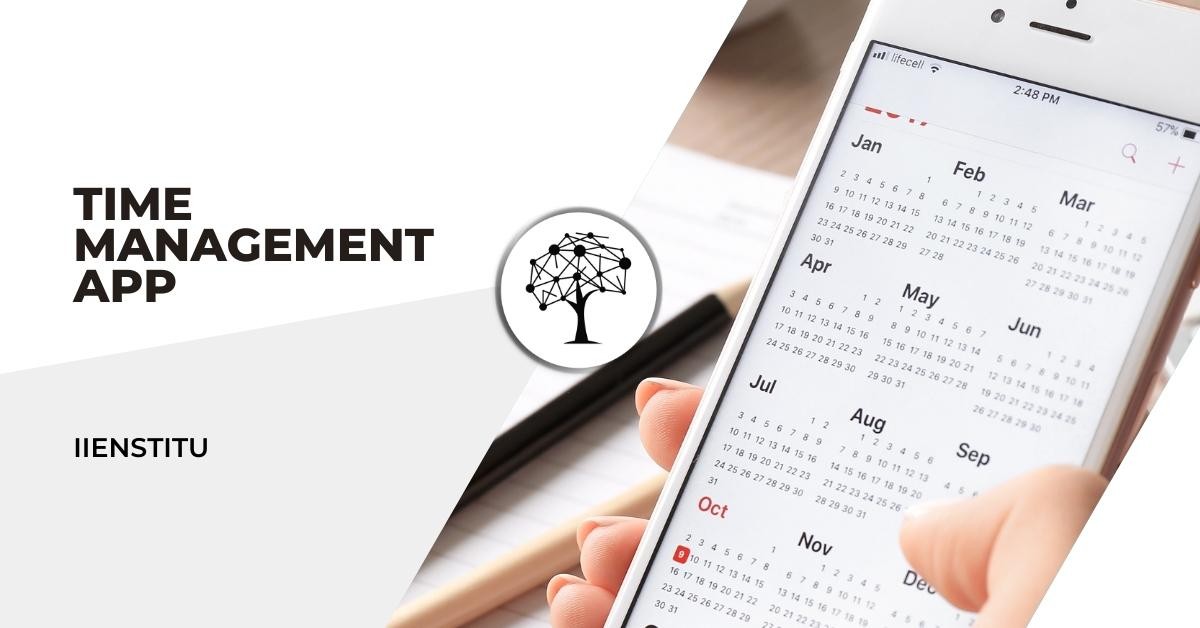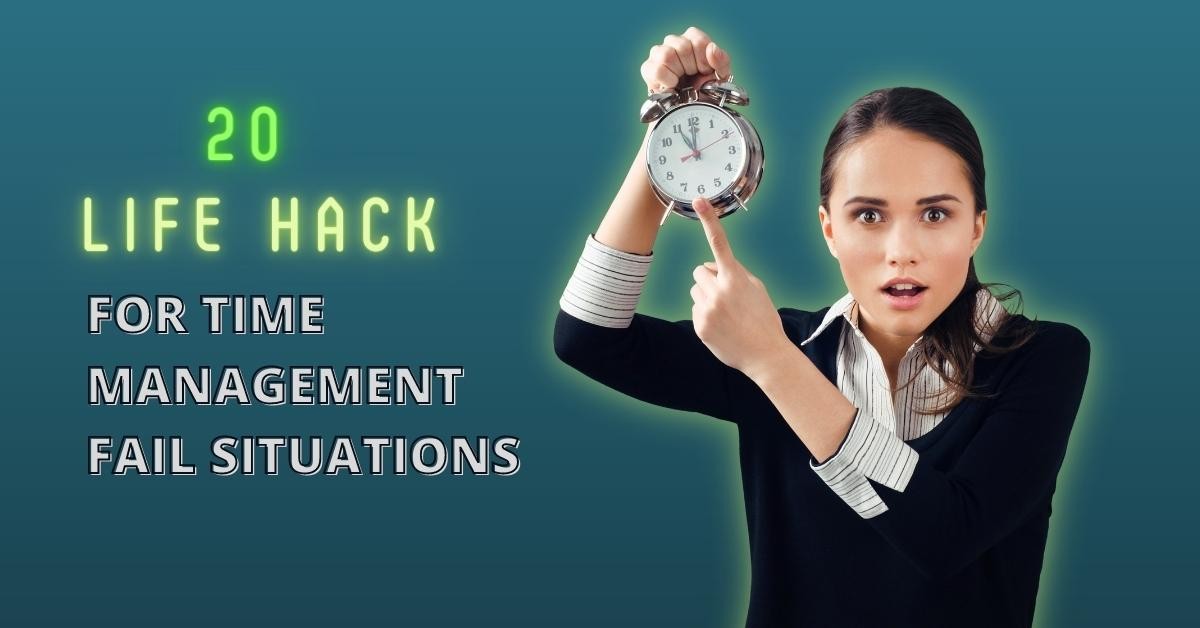
Time management is about managing yourself. So many of the demands on our lives are out of our control, but we can modify how we react to them and influence what actions we will take. When organizing your schedule, it's essential to ask yourself honestly if this is something you genuinely need or want to be doing. Time is too precious to waste on things that don't bring us joy or fulfill our purpose in life.
Related Course: Free Time Management Course
A time management matrix can help prioritize what tasks must be done, what can be put off until later, and which ones should never get scheduled (PF). There are four quadrants within the matrix:
Quadrant 1 – Must-Do or Should-Do Tasks: These are important tasks that need to be done, but they can often be delayed until later.
Quadrant 2 – Important but Not Urgent: These tasks should be scheduled, but they can wait until more time.
Quadrant 3 – Urgent but Not Important: These are the tasks that need to be done now, but they are not very important.
Quadrant 4 – Neither Urgent nor Important: These tasks can be easily skipped or delegated to someone else.
When creating your schedule, it's essential to place the most important and urgent tasks in Quadrant 1. This ensures that you address the most pressing matters first and don't fall behind. Lessons in Quadrant 2 should be scheduled for later when you have more room in your calendar. Quadrant 3 is for tasks that need to be done now, but they are not very important. If there are multiple tasks in this category, it's best to focus on the most urgent ones first. Lastly, Quadrant 4 should be avoided if possible, as these tasks can easily be skipped or delegated to someone else.
Creating a time management matrix can be a great way to help organize your schedule and prioritize essential. It's critical to be realistic and understand that some tasks will never fit into your ideal plan. But by using the matrix as a guide, you can at least avoid charges that aren't important and those that are urgent but not important. In addition, using a time management matrix can help you feel less overwhelmed and have more reasonable expectations of what you have time to do (PF).
Create a list of tasks to be completed
A task list is a great way to organize and keep track of the tasks you need to complete. You can create a list for work, school, or personal jobs. By making a list, you can ensure that each job is given the attention it deserves, and you can cross them off as they are completed! Here are some tips for creating an effective task list:
Make sure each task has a specific purpose or goal.
Keep your list short.
Write down the deadlines for each job.
Prioritize your tasks according to importance.
Break down larger tasks into smaller steps.
Use checkboxes or bullets to make it easy to read.
Creating a task list can be a great way to organize your thoughts and ensure that each task is given the attention it deserves. When creating your list, make sure to prioritize the tasks according to their importance and break down larger tasks into smaller steps. This will help you stay on track and avoid feeling overwhelmed. By using a task list, you can feel more in control of your time and better manage your responsibilities!
Prioritize the list based on importance and urgency
What does your list of to-do's look like? Are you prioritizing the list based on volume and urgency? If not, it may be time to read this blog post.
The most important tasks should be completed first because they are urgent, but sometimes we get so caught up in meeting the critical items that we forget about the more important ones. This can lead to getting overwhelmed at work with a messy desk or failing a deadline for a project due next week. It is essential to understand what is most important and needs attention now, even if it isn't pressing. One way to do this is by using Eisenhower's Urgent/Important Matrix, which will help you prioritize accordingly.
For everything on your plate to get done, it's essential to prioritize the list based on importance and urgency. The most important tasks should be completed first because they are urgent, but sometimes we get so caught up in completing the urgent items that we forget about the more important ones. This can lead to getting overwhelmed at work with an unorganized desk or forgetting a deadline for a project due next week. It is important to understand what is most important and what needs attention now, even if it isn't pressing. One way to do this is by using Eisenhower's Urgent/Important Matrix, which will help you prioritize accordingly.
The Urgent/Important Matrix is a tool created by Dwight D. Eisenhower, 34th president of the United States, that can help individuals manage their priorities. This matrix helps you prioritize your tasks depending on if they are urgent or important and can help individuals cut through the clutter to do what matters! If a task is both urgent and essential, it should be completed immediately. If a job is critical but not essential, it should be eliminated as it does not have much value. If a task is not urgent but important, it can be scheduled later when time permits. When all of the items in each column of the matrix are addressed, you will notice an improvement in time management skills along with an increase in productivity.
However, this might seem like common sense (prioritize by importance). Some people make lists of all things that need to be done without thinking about what is urgent and important. This can lead to feeling overwhelmed and not knowing where to start. The Urgent/Important Matrix will help you focus on the most important tasks at hand and avoid feeling overwhelmed.
The Urgent/Important Matrix is a great way to categorize your tasks so that you can focus on the most important ones first. By using this tool, you can complete more tasks in a shorter amount of time, which can lead to a decrease in stress levels. Time management is an important skill for everyone, especially those who feel like they don't have enough time for themselves. The Urgent/Important Matrix will help you stay.
If you are feeling overwhelmed and lack time for yourself, it is important to prioritize your tasks. It is also essential that you manage your time by breaking down large projects into smaller steps to get everything done without feeling like a failure.
Schedule time for each task, making sure not to over-schedule yourself
Have you ever felt like your day was so busy, but there is just no way it could be? Have you ever found yourself in the evening, with no clue how to get everything done that needs to happen? What if I told you that this feeling of being over-scheduled and overwhelmed is something that many people experience on a regular basis. You are not alone!
It's important to schedule time for each task, making sure not to overschedule yourself. It can be tempting when we have so much going on in our lives and every moment feels valuable. But taking care of ourselves by creating balance is an essential part of living a healthy life. Remember: most things will still need doing even if they don't get done today.
It is essential to recognize that this feeling of being over-scheduled and overwhelmed is a very common experience. By recognizing the signs of stress early on, you can make a conscious effort to create balance in your life.
If you find yourself overscheduled and overwhelmed with tasks, it may be time to sit down and make a list based on importance and urgency. This will help you organize your thoughts and prioritize what needs attention immediately versus what can be postponed for later. Try using Eisenhower's Urgent/Important Matrix, which will help you cut through the clutter to get everything done without feeling like a failure!
In order to manage your time more efficiently, break big projects into smaller steps that can be done in shorter periods
Finding the balance between fun and work can sometimes be a struggle, but it is essential to carve out some time for yourself. It is not healthy to constantly put work before your personal needs as this will eventually lead to complete burnout. Self-care should be an essential part of everyone's schedule as it helps you stay focused on your goals, provides a time for reflection, and allows you to recharge if you feel overwhelmed or stressed out.
By recognizing the signs of stress early on, you can make a conscious effort to create balance in your life. If this seems difficult, try using Eisenhower's Urgent/Important Matrix, which will help you cut through the clutter and get everything done without feeling like a failure!
It is important that you schedule time for yourself, even if it means postponing some tasks. Most things will still need doing even if they don't get done today!
If you have free time, use it wisely by planning ahead or taking care of small tasks that can be done quickly.
If you have free time, be sure to use it wisely by planning ahead or taking care of small tasks. This can help you make the most of your time and stay productive. For example, if you have a project due soon, use your free time to research what you need to do or gather materials. Or, if there are some errands you need to run, take care of them during your spare moments instead of letting them pile up. By using your free time in this way, you'll be able to accomplish more and feel more productive overall!.
Managing your time can be difficult if you're always on the go. If this sounds like you, try making a list of daily tasks and setting reminders on your phone or computer for when it's time to get started. There are also some great online tools such as Teux Deux and Google Calendar, which can help make things easier. By using these strategies, you'll be able to stay on top of all your responsibilities while still enjoying some free time!
Track your progress throughout the day and reevaluate if needed
The day is a long time, and sometimes it feels like we're trying to run the whole thing on fumes. There's no way that you can accomplish all of your goals in one day, but there are some things that you can do each morning to set yourself up for success. The first step is tracking your progress throughout the day and reevaluating if needed. Here's how::
-You can start by writing down all of your goals at the beginning of the day and then checking in throughout to see how you're doing. This will help you prioritize what's most important without feeling overwhelmed by everything you have left to accomplish.
-Another strategy is to make a list each evening of things that went well during the day and tasks which could be improved on. At the end of each week, take some time to reflect on your progress and plan for the next week accordingly. This gives you a chance to adjust things as necessary instead of wasting valuable time in between!
The early bird gets the worm - remember that by starting your day off with a clear plan in mind, you can stay productive and motivated throughout the rest of it. If you're not sure where to start, try using free online tools like Google Calendar or Deux Deux, which can help make things easier. By using these strategies, you'll be able to stay on top of all your responsibilities while still enjoying some free time!
Take care of small tasks when they arise.
It may seem more straightforward to prioritize large, meaningful tasks instead of taking care of smaller ones. However, this isn't the most efficient way to use your time. Taking care of small jobs as they come up will help ensure that none slip through the cracks and will keep your To-do list manageable at the same time! Here are some tips for managing those smaller items:
Track what does and does not need to be done
One way to take care of small tasks quickly and efficiently is by trackings what does and does not need to be done. This can be done in several ways, such as using a checklist or creating an outline for your project. By doing this, you'll be able to see what still needs to be done and avoid any overlap between tasks.
Use technology to your advantage.
Technology can be a great help when taking care of small tasks. For example, if you have a job that needs to be completed soon, use your phone or computer to set a reminder for yourself. There are also some great online tools such as Teux Deux and Google Calendar, which can help make things easier. By using these strategies, you'll be able to stay on top of all your responsibilities while still enjoying some free time!
Reward yourself with something positive when you complete a task or set of functions!
It's important to reward yourself for completing tasks. It helps you feel accomplished and builds up your self-esteem. There are many ways to reward yourself, but our favorite way is with something positive!! For example, you could take a break to eat your favorite food, watch your favorite show, or get in some extra family time. Whatever makes you happy, go for it! Just make sure that the reward doesn't interfere with your productivity.
The Time Management Matrix is an excellent tool for prioritizing what is essential to get everything done without feeling like a failure or Putting Yourself First (PF). It can be helpful to start by writing down all of your goals at the beginning of the day and then checking in throughout to see how you're doing. This will help you prioritize what's most important without feeling overwhelmed by everything you have left to accomplish. You can also make a list each evening of things that went well during the day and tasks which could be improved on. Then, at the end of each week, take some time to reflect on your progress and plan for the next week accordingly. This gives you a chance to adjust things as necessary instead of wasting valuable time in between!
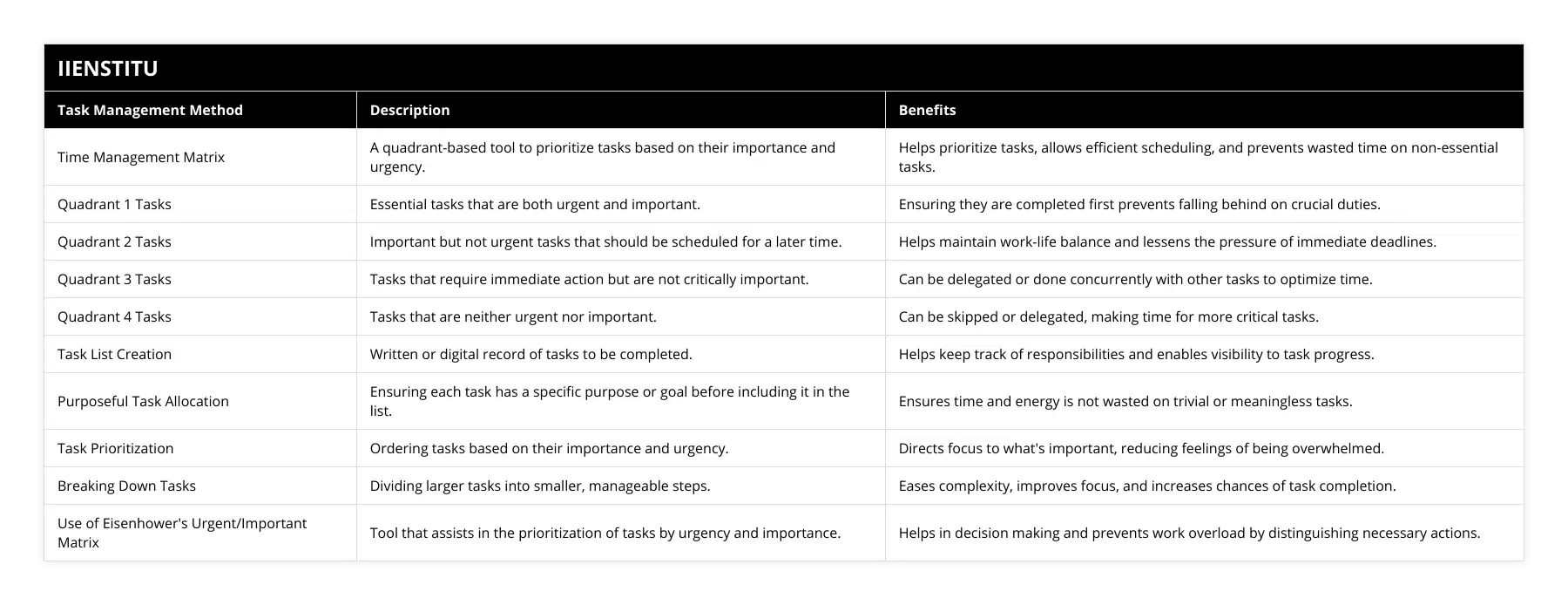
Frequently Asked Questions
What is a time management matrix?
Time Management Matrix: Definition and Importance
A time management matrix is a valuable tool for organizing and prioritizing tasks, helping individuals enhance productivity and effectiveness. This matrix assists in allocating time and resources based on the importance and urgency of tasks, resulting in efficient planning and better performance.
Stephen Covey's Four Quadrants
Developed by Stephen Covey, a renowned efficiency expert, the matrix categorizes tasks into four quadrants. Each quadrant signifies varying levels of importance and urgency, helping differentiate crucial tasks from less significant ones. These quadrants are:
Important and Urgent: High-priority tasks requiring immediate attention, such as deadlines and crises.
Important but Not Urgent: Significant tasks that contribute to long-term goals and values, including planning and relationship-building.
Urgent but Not Important: Tasks that demand immediate attention, yet do not contribute to goals, such as interruptions and minor requests.
Not Urgent and Not Important: Trivial tasks or distractions, which often waste time and do not align with objectives.
Benefits of the Time Management Matrix
This matrix offers a structured approach to managing tasks, enabling individuals to effectively maintain professional and personal responsibilities. Some key advantages include:
- Reduced stress: Prioritizing tasks allows for a balanced workload, minimizing stress, and preventing burnout.
- Enhanced focus: By identifying critical tasks and eliminating distractions, individuals can focus on essentials, improving productivity.
- Goals' alignment: The matrix helps users allocate time to tasks that contribute to their objectives, fostering goal-oriented behavior.
- Time savings: Performing tasks efficiently results in additional time for leisure or self-improvement activities.
How to Implement the Time Management Matrix
To successfully employ this tool, follow these steps:
Identify tasks: List all responsibilities and duties, including personal and professional commitments.
Categorize tasks: Assign each task to a quadrant, evaluating its importance and urgency.
Prioritize assignments: Focus on high-priority tasks and delegate or eliminate less relevant ones.
Schedule time: Allocate dedicated time slots to complete tasks, ensuring consistent progress towards goals.
By incorporating the time management matrix into daily routines, individuals can optimize their time usage, effectively balance competing responsibilities, and enhance overall productivity.
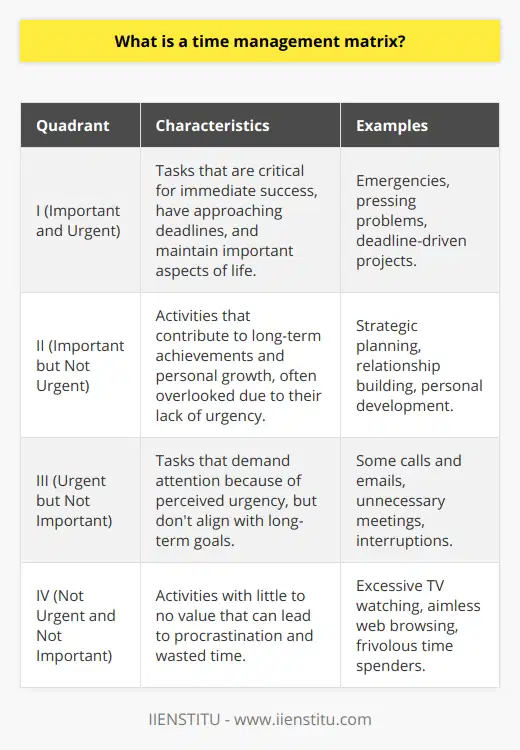
What are the 4 categories of time management matrix?
The Four Categories of Time Management Matrix
Understanding Quadrants
The Time Management Matrix is a valuable tool used to organize tasks by assessing them based on urgency and importance. Developed by Stephen Covey, this matrix is divided into four quadrants, each representing different levels of urgency and importance for various tasks.
Quadrant 1: Urgent and Important
The first quadrant entails critical tasks that require immediate attention. These are crucial for meeting goals, and they need to be addressed right away. Examples of such tasks may include completing project deadlines, dealing with crises, or addressing unexpected issues.
Quadrant 2: Non-Urgent but Important
The second quadrant consists of tasks that are important yet can be planned for a later time. Quadrant 2 tasks help in achieving long-term objectives and personal growth. These may include setting long-term goals, networking, exercising, or personal development activities.
Quadrant 3: Urgent but Not Important
The third quadrant encompasses tasks that appear urgent but hold little importance. These are often distractions that consume time without providing significant benefits. Some examples of quadrant 3 activities are replying to non-essential emails, attending unproductive meetings, or managing interruptions.
Quadrant 4: Non-Urgent and Not Important
The fourth quadrant houses tasks that are neither urgent nor important. These activities are trivial time-wasters that should be minimized or eliminated to focus on more meaningful pursuits. Examples could be excessive social media browsing, watching TV, or procrastination.
Effective Time Management
To implement efficient time management using this matrix, it is crucial to prioritize tasks in quadrants 1 and 2. Addressing urgent and important tasks in quadrant 1 prevents crises and promotes productivity. Meanwhile, engaging in quadrant 2 activities helps in achieving long-term goals and maintaining a balanced lifestyle.
Minimizing or eliminating quadrant 3 and 4 tasks not only conserves time but also directs focus towards more significant activities. Being mindful of how tasks are classified within the matrix aids in distinguishing between essential tasks and distractions, ultimately leading to effective time management.

What are the different types of time management matrix?
Types of Time Management Matrix
Eisenhower Matrix
The first type of time management matrix is the Eisenhower Matrix, named after the former U.S. President Dwight D. Eisenhower. This matrix categorizes tasks into four basic quadrants based on their urgency and importance. Quadrant I contains urgent and important tasks, Quadrant II holds non-urgent but important tasks, Quadrant III includes urgent but non-important tasks, and Quadrant IV is for non-urgent and non-important tasks. This matrix helps prioritize tasks and allows individuals to make effective decisions regarding time allocation.
Time Management Matrix by Stephen Covey
Another type of time management matrix is the one proposed by Stephen Covey, an American educator and author known for his work on leadership and time management. Covey's matrix expands on Eisenhower's concept by identifying different roles or areas of life. He encourages individuals to allocate time to all areas, ensuring a balanced approach to personal and professional development. Covey's matrix uses the same four-quadrant structure as Eisenhower's, but the focus is on work-life balance and long-term planning.
ABC Method
A third type of time management matrix is the ABC method, used primarily for prioritizing tasks based on their benefits or potential consequences of not completing them. Tasks are labeled as either A (highest priority), B (medium priority), or C (lowest priority) and are completed accordingly. This method emphasizes the importance of focusing on high-priority tasks to gain maximum benefits with minimal time investment.
Pareto Principle
Lastly, the Pareto Principle, also known as the 80/20 rule, is another approach to time management. According to this principle, 80% of the value or results within a task come from 20% of the work or effort. By identifying and focusing on these high-impact tasks, individuals can improve their time management and significantly increase productivity.
In conclusion, different types of time management matrices, such as the Eisenhower Matrix, Stephen Covey's matrix, the ABC method, and the Pareto Principle, offer various approaches to prioritize tasks and allocate time effectively. Choosing the right matrix depends on an individual's personal preferences, work requirements, and long-term goals.
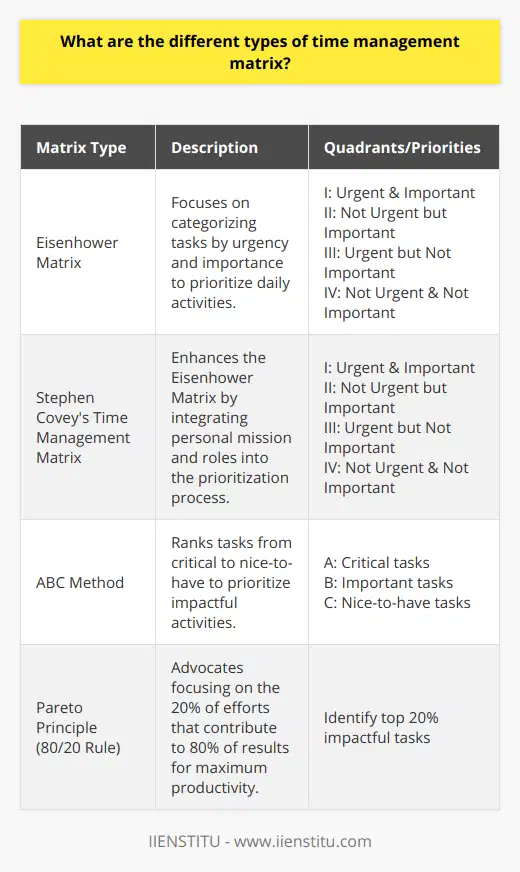
What are the 4 quadrants of the Eisenhower Matrix?
**Introduction to the Eisenhower Matrix**
The Eisenhower Matrix, also known as the Time Management Matrix, is a prioritization tool designed to improve an individual's efficiency in accomplishing tasks. It categorizes tasks into four quadrants based on their urgency and importance. The matrix, named after President Dwight D. Eisenhower, aids in identifying which tasks require immediate attention and which can be deferred or delegated.
**Quadrant 1: Urgent and Important**
The first quadrant in the Eisenhower Matrix comprises tasks that are both urgent and important. These tasks require immediate attention, as not addressing them may lead to significant consequences. Examples include dealing with emergencies, meeting vital deadlines, and addressing pressing problems.
**Quadrant 2: Important but Not Urgent**
Quadrant 2 tasks are important but not time-sensitive. These tasks tend to impact long-term success and are often associated with personal development, strategic planning, and relationship building. Investing time in quadrant 2 activities can result in better problem-solving, reduced stress, and increased productivity.
**Quadrant 3: Urgent but Not Important**
The tasks in quadrant 3 may appear pressing, but they do not contribute significantly to one's overall goals. These tasks often involve interruptions, responding to unimportant emails, and attending unnecessary meetings. Identifying and delegating quadrant 3 tasks can free up time and energy for more important activities.
**Quadrant 4: Neither Urgent nor Important**
Lastly, quadrant 4 represents activities that are neither urgent nor important. These tasks typically involve idle pastimes or distractions, such as excessive scrolling on social media, watching television, or engaging in trivial conversations. Limiting time spent on quadrant 4 tasks can greatly enhance overall productivity and accomplishment.
In conclusion, the Eisenhower Matrix provides a useful framework for organizing tasks according to their urgency and importance. By allocating time and resources more effectively, individuals can increase productivity, reduce stress, and achieve greater success in both their personal and professional lives.
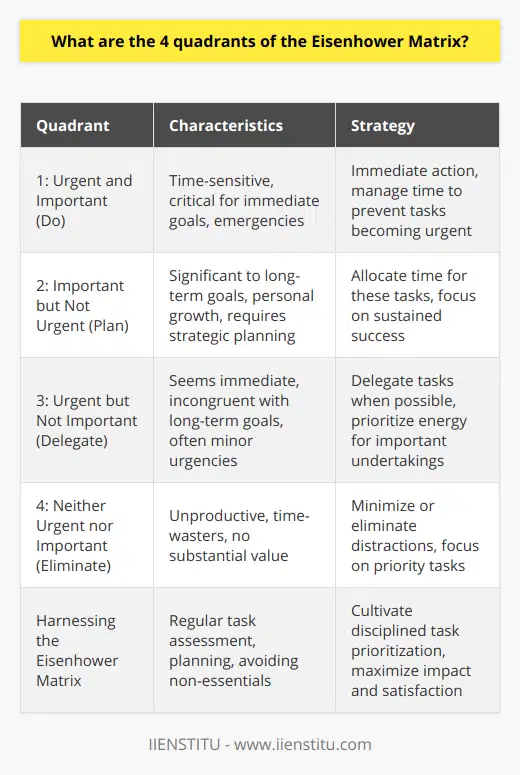
How do you create a time management matrix?
Creating a Time Management Matrix
**Identify Tasks**
The initial step in developing a time management matrix involves identifying all tasks and responsibilities required to be completed. This may encompass personal, professional or academic goals; it is essential to have a comprehensive list to maximize the matrix's utility.
**Categorize Tasks**
Next, classify the tasks into four primary categories using the Eisenhower matrix method. These categories are:
Urgent and Important (Quadrant 1): Tasks demanding immediate attention and are essential to meeting your goals.
Not Urgent but Important (Quadrant 2): Tasks relevant to your objectives but can be scheduled for later.
Urgent but Not Important (Quadrant 3): Tasks requiring prompt handling, yet are not directly related to your long-term aspirations.
Not Urgent and Not Important (Quadrant 4): Tasks with minimal impact on your overall goals and can be delayed or delegated.
**Prioritize Tasks**
Assign each task to one of the quadrants and prioritize them accordingly. Focus on Quadrant 1 tasks first, ensuring their completion before moving to the next quadrant.
**Schedule Tasks**
Allocate specific timeframes to address Quadrant 2 tasks. It is crucial to devote adequate attention to these important but non-urgent tasks to prevent them from escalating into Quadrant 1.
**Delegate or Eliminate**
For tasks in Quadrants 3 and 4, consider delegating or eliminating them entirely. By doing so, you can optimize your focus on tasks that directly contribute to your goals.
**Reassess Regularly**
Finally, regularly review your time management matrix to keep track of your tasks and priorities. Update your matrix as new assignments arise or as the importance and urgency of existing tasks change.
In conclusion, creating a time management matrix helps in organizing and prioritizing tasks. By categorizing tasks based on urgency and importance, individuals can optimize their time and energy to achieve their goals effectively. Regularly revisiting the matrix supports continuous improvement and ensures that designated priorities align with desired outcomes.

What are the 4 P's of time management?
The 4 P's of Time Management
Prioritization
The first 'P' in time management is prioritization. The essence of effective time management lies in identifying the most important tasks and focusing on them. By employing the Pareto Principle (80/20 rule), one can distinguish between the vital few tasks and the trivial many, ensuring that attention is given to what matters most. This allows for better allocation of time and resources, leading to increased productivity and satisfaction.
Planning
The second 'P' of time management is planning, which involves a conscious decision-making process for organizing time and resources. By setting clear objectives, outlining steps to achieve goals, and allocating time slots for each activity, it becomes easier to monitor progress and stay on track. Planning optimizes time utilization and ensures the completion of tasks in a structured and efficient manner. Implementing tools such as calendars, to-do lists, and time management apps can assist in planning effectively.
Persistence
The third 'P' of time management is persistence, highlighting the importance of consistency and continuity in pursuing goals. It is essential to maintain motivation and persistence in the face of obstacles, distractions, or setbacks. Practicing self-discipline, establishing routines, and holding oneself accountable are key strategies for enhancing persistence in time management. By staying committed to tasks and prioritizing consistently, it is possible to develop strong time management habits and achieve long-term success.
Prevention
The fourth and final 'P' of time management is prevention. This involves identifying potential pitfalls, distractions, and time-wasters, and taking proactive steps to eliminate or minimize their impact. By anticipating obstacles and formulating contingency plans, it becomes easier to maintain focus and productivity. Additionally, adopting healthy habits such as regular breaks, exercise, and a balanced diet can contribute to better time management by enhancing focus, energy, and overall mental clarity.
In conclusion, the 4 P's of time management – prioritization, planning, persistence, and prevention – encapsulate the core principles necessary for achieving better time management skills. By incorporating these principles, individuals can enjoy improved productivity, reduced stress, and a more satisfying and balanced life.
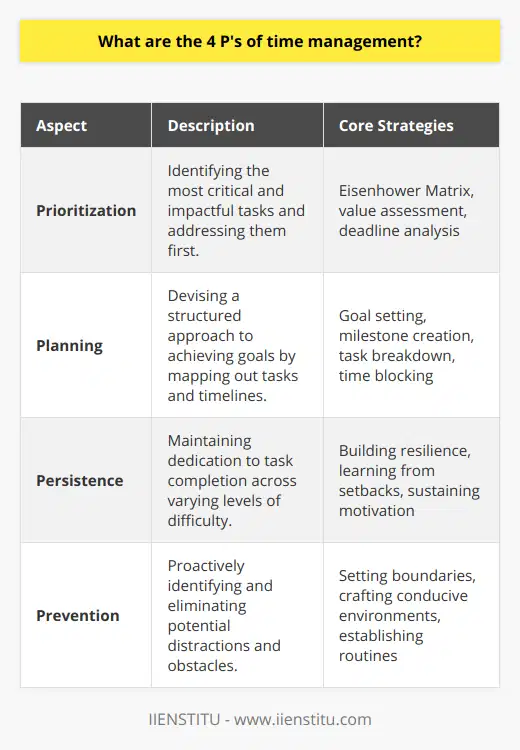
What is the significance of the 4 quadrants in Stephen Covey's time management matrix for prioritizing tasks?
Understanding Covey's Time Management Matrix
The four quadrants in Stephen Covey's time management matrix play a crucial role in prioritizing tasks, allowing individuals to manage their time effectively and efficiently. Each quadrant represents different types of tasks and their respective urgency and importance levels, guiding individuals to plan their daily, weekly, and long-term activities based on their priorities.
Quadrant 1: Urgent and Important Tasks
Quadrant 1 encapsulates tasks that are both urgent and important, requiring immediate attention. These activities often involve crises, deadline-driven projects, and essential commitments. Focusing on quadrant 1 tasks prevents unnecessary stress and enhances decision-making, while neglecting them might lead to severe consequences.
Quadrant 2: Important but Not Urgent Tasks
Quadrant 2 emphasizes tasks that are important but not urgent, including planning, relationship-building, and personal development. By allocating time consistently to quadrant 2 tasks, individuals can foster long-term growth and avoid becoming overwhelmed by emergencies. Neglecting this quadrant contributes to poor planning, work-life imbalance, and weak relationships.
Quadrant 3: Urgent but Not Important Tasks
Quadrant 3 highlights tasks that are urgent but not important, such as interruptions, meetings, and attending to other people's priorities. These activities are usually time-consuming and not directly aligned with an individual's goals. Understanding their insignificance enables individuals to minimize time spent on such tasks, focusing more on the important ones.
Quadrant 4: Not Urgent and Not Important Tasks
Finally, quadrant 4 encompasses tasks that are neither urgent nor important, often characterized as distractions or time-wasting activities. Examples include excessive leisure, aimless browsing on the internet, or watching television without purpose. Spending excessive time in quadrant 4 hinders productivity and detracts from the achievement of personal and professional goals.
In conclusion, understanding and utilizing the four quadrants of Stephen Covey's time management matrix effectively enables individuals to prioritize tasks efficiently. By identifying and categorizing tasks based on urgency and importance, one can allocate time and resources appropriately, improving productivity, and ultimately leading to personal and professional growth.
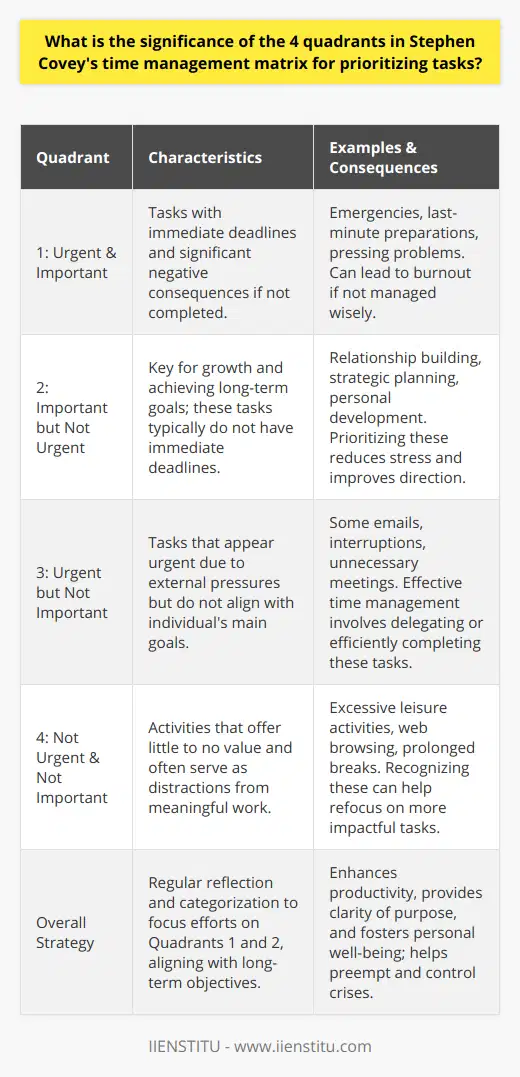
How can the Eisenhower Matrix be used to improve an employee's time management skills?
**Understanding the Eisenhower Matrix**
The Eisenhower Matrix is a time management tool that can significantly enhance an employee's ability to prioritize tasks and allocate time efficiently. It was developed by Dwight D. Eisenhower, who utilized this method not only as a US president but as a military commander as well. This matrix consists of a 2x2 grid, with each quadrant representing a combination of task urgency and importance.
**Task Categorization**
To improve time management skills, employees must first categorize their tasks according to their level of urgency and importance. The top-left quadrant (Q1) represents tasks that are both urgent and important, such as crises or deadlines. Tasks within this quadrant should be completed immediately. The top-right quadrant (Q2) encompasses tasks that are important but not urgent, including long-term goals, planning, and relationship building. The focus should be on scheduling these tasks accordingly. The bottom-left quadrant (Q3) contains tasks that are urgent but not important, often involving interruptions or requests from others. Delegation or deferring tasks can be a suitable option to manage these tasks. Lastly, the bottom-right quadrant (Q4) includes tasks that are neither urgent nor important, such as time-wasting activities. Employees should aim to minimize or eliminate these tasks altogether.
**Developing a Strategy**
Once tasks are categorized, employees can establish a strategy to accomplish their duties effectively. Tackling Q1 tasks immediately ensures that crucial deadlines are met, while consistently working on Q2 tasks promotes long-term efficiency and success. Delegating or deferring Q3 tasks can free up time, and eliminating Q4 tasks helps the employee focus on genuinely valuable work. By adhering to this strategic method, employees can optimize their productivity and improve their time management skills.
**Adopting a Routine**
In order to maintain proficient time management, employees may develop a routine of revising the Eisenhower Matrix daily. By evaluating and organizing tasks each day, employees can ensure that priorities are consistently managed, time is effectively allocated, and goals are regularly redefined. This routine provides an agile approach towards time management and facilitates continuous improvement.
**Embracing a Proactive Mindset**
The Eisenhower Matrix not only improves an employee's time management skills but also instills a proactive mindset. By actively categorizing tasks, employees are encouraged to prioritize multiple responsibilities and minimize procrastination. This proactive approach enables employees to be better prepared for unexpected situations and enhances overall effectiveness.
In conclusion, the Eisenhower Matrix is a valuable tool for employees seeking to improve their time management skills. By categorizing tasks, establishing a strategy, adopting a routine, and embracing a proactive mindset, employees can boost their productivity while ensuring the accomplishment of critical tasks.
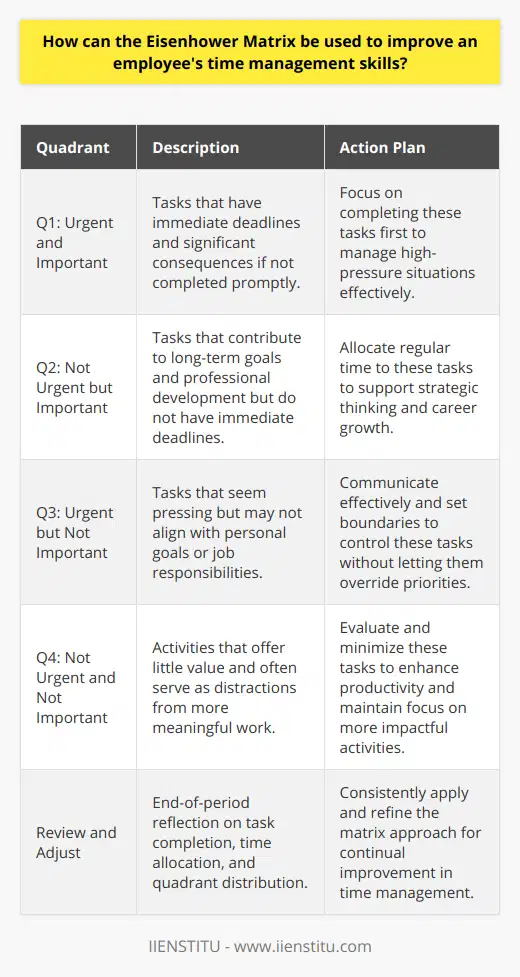
What are the key differences between the 4 quadrants of the time management matrix and how can they be applied in a workplace setting?
Understanding the Time Management Matrix
The time management matrix, developed by Stephen Covey, is a valuable tool for organizing tasks and managing time effectively. Its four quadrants classify tasks based on urgency and importance, allowing for better prioritization and decision-making.
Quadrant 1: Urgent and Important Tasks
In workplace settings, this quadrant comprises tasks that require immediate attention, including critical projects, pressing deadlines, and crisis situations. To mitigate stress and ensure smooth workflow, employees should focus on completing these tasks promptly while remaining vigilant in addressing potential challenges.
Quadrant 2: Important but Not Urgent Tasks
This quadrant contains tasks critical for long-term success, such as professional development, strategy planning, and relationship building. Effective time management entails allocating regular time for these activities to prevent them from becoming urgent tasks while fostering productivity and future growth.
Quadrant 3: Urgent but Not Important Tasks
These tasks involve everyday activities, such as responding to emails, attending meetings, and handling administrative duties. In a workplace context, employees should delegate or automate these tasks, whenever possible, to devote more time to essential responsibilities. This approach minimizes the potential for distractions and maximizes the efficiency of the work environment.
Quadrant 4: Neither Urgent Nor Important Tasks
Finally, quadrant four consists of time-wasting activities, including excessive social media usage and other extraneous actions. Employees must proactively identify and eliminate these activities as they detract from productivity and overall organizational success.
Applying the Time Management Matrix
In summary, the time management matrix offers a valuable framework for prioritizing tasks and maximizing productivity in a workplace setting. By distinguishing between urgency and importance, employees can efficiently allocate time to essential responsibilities, contributing to individual and organizational success.
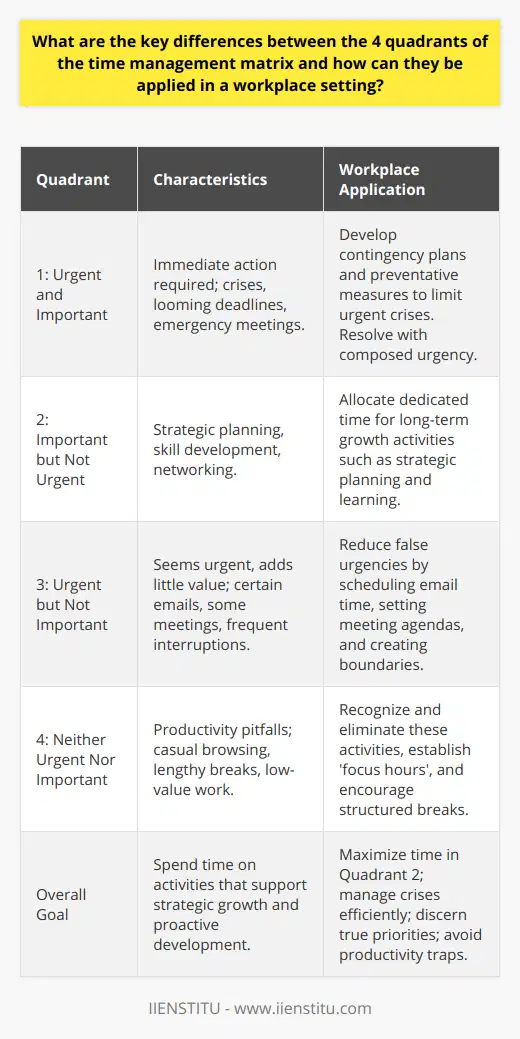
What is the time management matrix and strategy?
Time Management Matrix: Definition and Purpose
The time management matrix, also known as the Eisenhower Matrix, is a strategic tool designed to help individuals prioritize tasks based on their levels of urgency and importance. Created by President Dwight D. Eisenhower and later popularized by Stephen Covey in his book 'The 7 Habits of Highly Effective People,' this matrix aims to maximize productivity by enabling the optimal allocation of resources and time.
Quadrants of the Time Management Matrix
The matrix divides tasks into four quadrants: Quadrant I contains urgent and important tasks, such as crises and deadlines; Quadrant II encompasses vital but not urgent tasks, including long-term planning and building relationships; Quadrant III consists of tasks that are urgent but not important, such as interruptions and some meetings; and Quadrant IV represents tasks that are neither important nor urgent, like trivial matters and time-wasting activities.
Time Management Strategy: Principles and Implementation
The fundamental principle of the time management strategy is ensuring that sufficient attention is given to Quadrant II tasks, which contribute to long-term goals and personal development. By reflecting on one's priorities and allotting appropriate time for these tasks, individuals foster personal and professional growth while gradually decreasing the volume of Quadrant I tasks.
To implement this strategy, individuals should first create a list of all their tasks, categorize them according to the quadrants, and dedicate adequate time blocks for each category. This exercise helps to identify areas that require additional focus and reallocate resources suitably.
Digital Tools for Time Management
In today's digital age, various tools and applications can assist in managing the time management matrix. Examples include Eisenhower.app, Todoist, and Trello, which enable users to organize, prioritize, and track tasks efficiently. By incorporating such digital solutions, users can further optimize their time management efforts and boost overall productivity.
In conclusion, the time management matrix and strategy provide a comprehensive framework for prioritizing tasks and maximizing effectiveness. By consistently assessing and adjusting one's allocation of time to various tasks, individuals can ensure they maintain a balance between addressing urgent matters and investing in long-term growth.
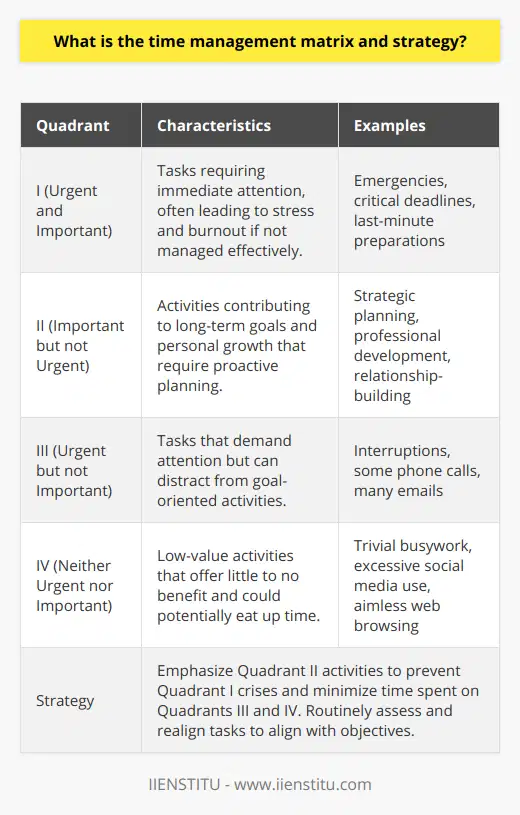
How to use Stephen Covey's time management matrix effectively?
Understanding the Matrix
Stephen Covey's Time Management Matrix offers an effective approach for prioritizing tasks and activities based on their urgency and importance. The matrix comprises four quadrants, each representing different levels of priority. To use the matrix effectively, individuals must first distinguish their tasks according to their significance and urgency.
Categorizing Tasks
Tasks in Quadrant 1 are both urgent and important, requiring immediate attention. These tasks often involve crises, deadlines, and pressing issues. Prioritizing Quadrant 1 tasks ensures that critical activities are accomplished promptly, thus preventing potential disasters. Quadrant 2 tasks are important but not urgent, encompassing activities such as planning, relationship building, and personal development. Focus on these tasks to achieve long-term goals and sustain personal well-being.
On the other hand, Quadrant 3 tasks are urgent but not important, typically consisting of interruptions, unnecessary meetings, or trivial demands from others. These tasks may appear time-sensitive but do not contribute meaningfully to personal or professional growth. Quadrant 4 tasks are neither urgent nor important, characterized by time wasters, distractions, or excessive leisure activities. Avoid these tasks to prevent procrastination and preserve time for more valuable pursuits.
Applying the Matrix
To apply Covey's matrix, begin by listing all tasks and activities required for a given period, such as a week or a month. Subsequently, classify each task into the appropriate quadrant. This will offer a clear visual representation of priorities and areas that demand attention.
Balancing Priorities
Strive to maintain a balanced approach when managing time through the matrix. While attending to Quadrant 1 tasks is crucial, do not neglect Quadrant 2 activities that contribute to personal and professional development in the long run. Allocate time and resources to these tasks to create a balanced schedule. Simultaneously, minimize or delegate Quadrant 3 tasks as they typically consume time without producing meaningful outcomes. Lastly, abstain from engaging in Quadrant 4 tasks as they hinder productivity.
Regularly Review and Adjust
Continuously evaluate and update the matrix to ensure its alignment with personal and professional goals. Regular assessments will enable individuals to stay on track with priorities, identify emerging challenges, and make necessary adjustments.
Conclusion
Using Stephen Covey's Time Management Matrix effectively entails understanding its structure, categorizing tasks appropriately, applying the matrix, balancing priorities, and consistently reviewing and adjusting one's approach. When implemented correctly, this matrix serves as a powerful tool for enhancing productivity, attaining goals, and promoting personal and professional growth.
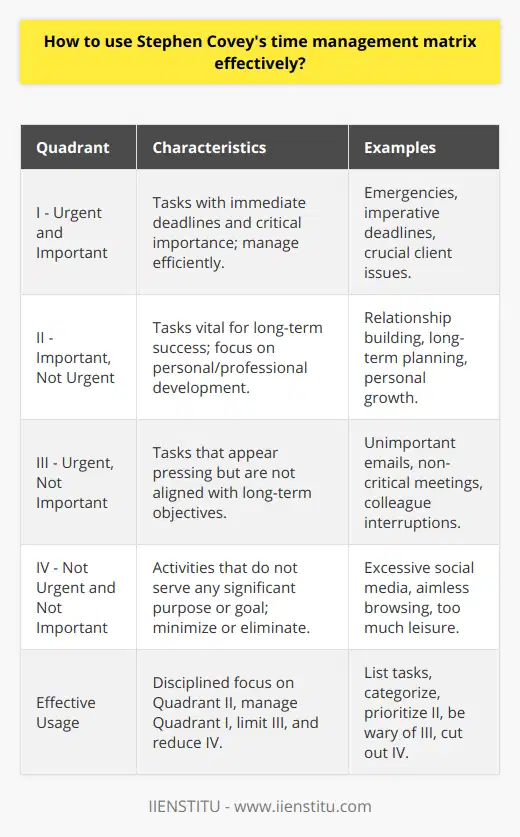
What is the ideal time matrix for employees to improve productivity?
Ideal Time Matrix for Enhanced Productivity
Understanding Employees' Work Patterns
An ideal time matrix for employees must consider their work patterns, as people vary in their most productive hours. Some employees excel during early mornings, while others perform better later in the day or night. A flexible schedule is essential for accommodating these differing preferences and maximizing output across the organization.
Effective Break Schedules
Incorporating breaks strategically within the day can help improve productivity. The Pomodoro Technique encourages dividing work into focused 25-minute intervals, followed by a five-minute break, with a longer break every two hours. Further research suggests a 17-minute break after 52 minutes of work can enhance concentration, preventing mental fatigue and maintaining productivity throughout the day.
Balancing Workload Distribution
Productivity can be optimized by allocating tasks according to employees' energy levels at different times. Complex and mentally demanding tasks are best managed during employees' peak cognitive performance periods, while less intensive tasks can be scheduled during more relaxed periods. This approach reduces the risk of burnout and maintains enthusiasm.
Promoting Collaboration
Collaborative work yields positive results, but striking a balance by allowing employees time to work independently on tasks that require focus is crucial. The ideal matrix must designate specific timeframes for teamwork, brainstorming sessions, and one-on-one meetings, as well as allocating time for quiet, focused work.
Leveraging Technology
Utilizing time management tools can streamline the tracking, monitoring, and allocation of work. Companies can combine such tools with research-based best practices to enhance employees' performance. An efficient time matrix should emphasize data-driven results to accurately measure the productivity of each employee.
In conclusion, the ideal time matrix for employees to improve productivity should take individual work preferences into account and incorporate effective breaks, efficient workload distribution, the balance of individual and collaborative work, and the use of technology to optimize performance. By understanding and accommodating the diverse needs and strengths of employees, organizations can boost productivity overall.

